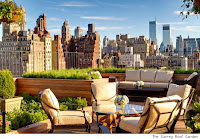It seems developers are back at flirting with hotel
developments again. Since hotels are perceived as riskier investments than
other commercial real estate (reflected in their pricing), a renewed appetite
is good sign of positive investor expectations towards real estate. With an increasing number of projects on the design board, I thought to share some of my thinking regarding what could be the new trends in hotel
design. Take this as loud thinking and by no
means a crystallized trend analysis.
--In the remote past hotels were places of status, appeal and
glamour. The Bristols’, the Continentals’, the Astorias’, the Savoys are all
hotel names that resonate with luxury, white gloved butlers, massive
chandeliers and huge rooms. Interestingly enough these names are not affiliated
brands. They just exist as traditional hotel names used by local hoteliers. At
the time there was little functionality involved in the design. It was all the exclusive
look and feel that mattered.
--In the recent past, with the increase of mobility, hotel design
was more about a combination of functionality and recreating the home
feel. Some used to argue though, that
travelers are not looking for something that is ‘home away’ but for better or at least different. Right or wrong it seems that trend wise
we have already put this behind.
--The most recent efforts were about combining the
experience (how
I feel while there?) and
motivation (why am I there?) driven design, and the
attempt to create the best of both. Think of the business
hotels tailored to corporate traveler’s needs, or the kids friendly hotels, family
resorts focused on an all including coherent experience. Emergence of
chic or hip hotel brands or
collections like
DesignHotels,
W,
Aloft,
Andaz,
MGallery, or
Morgans, etc. all
focused on
the lifestyle and the wow feel of spaces, often (not always) compromising on the
functionality. Then the
fashion brands extensions came along with
Armani,
Bvlgari and
Missoni hotels which I mainly see as mere branding exercises rather
than any substantial change in the fundamentals of hotel design.
For the short term future I don’t think there is a whole new
school of thought taking shape (if you know of any please share). What I see
more is that there are increasing efforts in keeping up with the changes in
life and consumption habits of people. Hotels are trying to become very high
tech in their distribution, appearance and experience offered. The lifestyle features (mainly interior
design related) are reinvented and recreated in an ever changing brand and
trend context but the basic fundamentals (like the bad, breakfast, bathroom
etc.) have not been addressed. Here are a few thoughts that do suggest some
concepts are being re-thought and we might see them spreading out in the hotel
world:
//Living lobby – recreating
the lobby as a living room, a multi-use space for casual talks, short informal meetings, logging into conf calls, or just work on your an ipad or notebook. Most of
these activities all go beyond a couch and a coffee table. They require small
bays, more intimate corners, visual barriers that segment the space, tables
with varying height, sockets everywhere, etc. and above all much personality, though
design but also through service.
//Light on lighting
– There is no traveler on earth that has not been annoyed by the light
controls in a rooms. There is a typical case of less is more. Having 3-4 predefined lighting schemes (e.g.
lounge/reading mode, office/desk mode, TV mode and full on/off) would just do a perfect job and spare you of playing piano on the light switchboard.
//Big Bed Small Room - Bed is an essential feature of hotels, but it takes up most of the space in the room, at least in the mid scale, economy hotels. We should find ways of using the space above the bed, during the day. Weather it's a temporary roll-in desk, pressing board, storage shelf, or other, I sense opportunities there. I have not seen solutions other than the folding bed that might be a compromise on the quality of the bed itself.

//Kitchen breakfast
– Breakfast is essential part of the hotel experience, more than the fine
dining that most luxury or upscale properties offer. But since the buffet concept, there hasn't been any revolutionary improvement on that front. The response on
the need for business breakfasts was also quite slow, or non-existent. Having more flexible breakfast areas with
several smaller kitchen-islands, including a small bar stool and chairs could
add a fresh feel and way people have breakfast. It would also make the process
a bit more fun and interactive.
Day Dining –
staying at the food subject, lobby bar food typically sucks. The whole lobby bar space should be rethought
moving away from the cocktail and coffee space clichés and make it more integrated with the lobby and
it’s diversity and multifunctionality.
//Top to toe – There
is always room to improve on the use of space from rooftop to basement of the
hotels. There are quite some properties with rooftop bars or pools, but
less so with extensions of executive lounges, or meeting rooms. Or even just a small garden for a newspaper or a coffee. Obviously sound
considerations should apply. Basements can also do much more than just a bar,
or a club. Parking coupled with value ad services like car cleaning, etc can offer
a good yield as well.
//TapTrip – It is
not strictly design related, but the tablet/smartphone experience of hotels is
also swiftly changing. We are not far from the online check-in solutions
(airlines have it for a decade now), and the touch your phone room key either.
But that’s a whole other subject…





































